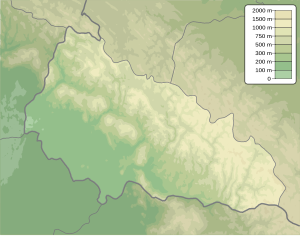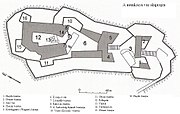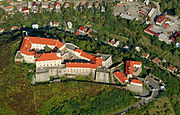Palanok Castle
| Palanok Castle | ||
|---|---|---|
|
View of the Palanok Castle |
||
| Alternative name (s): | Plankenburg, Munkach Castle | |
| Castle type : | Hilltop castle | |
| Conservation status: | Received or received substantial parts | |
| Place: | Palanok | |
| Geographical location | 48 ° 25 '53.4 " N , 22 ° 41' 16.1" E | |
|
|
||
The Palanok Castle (older also Plankenburg , also Munkach Castle ; Ukrainian Замок Паланок Samok Palanok , Hungarian Munkács vára ) is located in western Ukraine in the Transcarpathian Oblast , west of downtown Mukachevo in the Palanok district .
location
The very well-preserved castle is divided into 3 parts, the upper, middle and lower castle and is located on a 68 meter high massif of volcanic origin.
investment
The total area of the castle is about 14,000 square meters, it consists of about 130 rooms that are connected by a complex system of connecting corridors.
Today the castle houses a museum that deals with the history of the castle and the city of Mukachevo.
history
The foundation stone for the building was laid in the 14th century. the castle was used for defense for a long time.
The castle of Munkács (today Palanok Castle), like most castles in this area, was built by the Hungarian King Béla IV in the 13th century after the Mongol invasion to protect the borders of the Kingdom of Hungary to the north and east. In 1445 the city was declared a royal free city.
The most famous owners of the castle were the Rákóczi family. In the years 1685–1688 the castle was defended for three years by Jelena Zrinski against a siege army of the Habsburgs . After the end of the Hungarian uprising against the Habsburgs (1711 Peace of Sathmar ) led by Ferenc II Rákóczi , the Rákóczis lost the castle.
Emperor Charles VI. gave Mukatschewo and Tschynadijowo in 1726 to the Archbishop of Mainz, Elector Archbishop Lothar Franz von Schönborn , who had sent him two regiments to suppress the uprising. A year later it fell to his nephew Friedrich Karl von Schönborn-Buchheim . The property was one of the largest in Eastern Europe and in 1731 consisted of 4 cities and 200 villages with a total area of 2,400 square kilometers. It remained in the possession of the Counts of Schönborn until the 20th century .
From the end of the 18th century until 1897 the castle was used as a barracks and prison. It was later converted into an imposing fortress by French fortress builders and used as a pan-European prison after the storming of the Bastille (from 1796 to 1897). During the Napoleonic Wars between 1805 and 1806, even the Stephanskrone (Hungarian royal crown) was kept here. Until 1926 the premises were used as barracks, later an agricultural school existed here. The Greek freedom fighter Alexander Ypsilantis was imprisoned in the dungeon of the castle from 1821 to 1823.
photos
Plankenburg with Turul (right)








